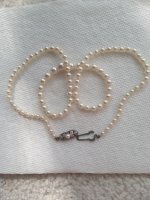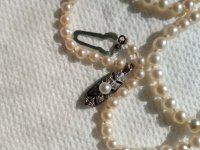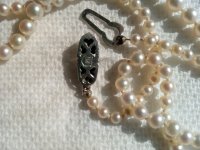guinea-pig-mafia
Community member
- Joined
- Oct 9, 2024
- Messages
- 5
Hello everyone! I am a first time poster but long-time enthusiast of gemstones and jewelry, especially vintage and antique pieces. I am definitely an amateur, especially when it comes to pearls, so I am hoping you can help me identify this find!
I would appreciate any insight on what I have and/or advice on how best to proceed in cleaning them up and caring for them. I am happy to provide more pictures or information- just let me know! Thank you in advance for your help!








- History: I found this string of pearls at a local antique shop yesterday, mixed with a lot of other strings. I pulled it out just because the lustre of the pearls was much superior to the others. I have no idea how long they were there but they were in the bottom of the pile. There is no box or documentation, just the strand. The shop was closing so I paid $25 for them and only after I left looked at the clasp even though I know better!
- Clasp: Am I correct that is the Mikimoto shell stamp? I do not see a metal mark anywhere. See photos front and back. Could that mean a sliver clasp? Or could I be dealing with a counterfeit?
- Length: Measures about 20.5” tip to tip, or 20” not including the clasp. It’s about 9.5” drop when closed (see photos).
- Pearls: They are gritty when rubbed together; I am quite sure they are genuine (I have a 10x loupe I looked them over with as well).
- Size: graduated, ranges between 3.5-7mm (see photos).
- Color: cream, seems to have some pink hues but they are absolutely filthy as you can see in the photos. I have not cleaned them so some of the discoloration is grime (especially on the smaller ones which would have been on the neck more) but I am unsure how much. I have never given pearls a bath before so I am a bit nervous about it, especially since the hardware next to the clasp seems to be corroding (see photos). I fear I won’t be able to get a good feel for color/quality until they are clean. Several places I thought might be damage were grime when I gently rubbed with a cloth on the spot.
- They needed a restringing a few decades ago and the tension is a mess on one side.
I would appreciate any insight on what I have and/or advice on how best to proceed in cleaning them up and caring for them. I am happy to provide more pictures or information- just let me know! Thank you in advance for your help!




